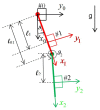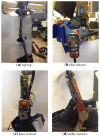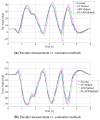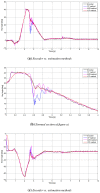The use of accelerometers and gyroscopes to estimate hip and knee angles on gait analysis
- PMID: 24828578
- PMCID: PMC4063036
- DOI: 10.3390/s140508430
The use of accelerometers and gyroscopes to estimate hip and knee angles on gait analysis
Abstract
In this paper the performance of a sensor system, which has been developed to estimate hip and knee angles and the beginning of the gait phase, have been investigated. The sensor system consists of accelerometers and gyroscopes. A new algorithm was developed in order to avoid the error accumulation due to the gyroscopes drift and vibrations due to the ground contact at the beginning of the stance phase. The proposed algorithm have been tested and compared to some existing algorithms on over-ground walking trials with a commercial device for assisted gait. The results have shown the good accuracy of the angles estimation, also in high angle rate movement.
Figures











References
-
- Casadio M., Morasso P.G., Sanguineti V. Direct measurement of ankle fness during quiet standing: Implications for control modeling and clinical application. Gait Posture. 2005;21:410–424. - PubMed
-
- Chacon-Murguia M.I., Sandoval-Rodriguez R., Arias-Enriquez O. Human Gait Feature Extraction Including a Kinematic Analysis Toward Robotic Power Assistance. Int. J. Adv. Robot. Syst. 2012;9:68–76.
-
- Santhiranayagam B.K., Lai D., Shilton A., Begg R., Palaniswami M. Regression Models for Estimation Gait Parameters Using Inertial Sensors. Proceedings of the 2011 Seventh International Conference on Intelligent Sensors, Sensor Networks & Information Processing (ISSNIP); Adelaide, Australia. 6–9 December 2011; pp. 46–51.
-
- Morris J.R.W. Accelerometry—A technique for the measurement of human body movements. J. Biomech. 1973;6:729–736. - PubMed
Publication types
MeSH terms
LinkOut - more resources
Full Text Sources
Other Literature Sources

